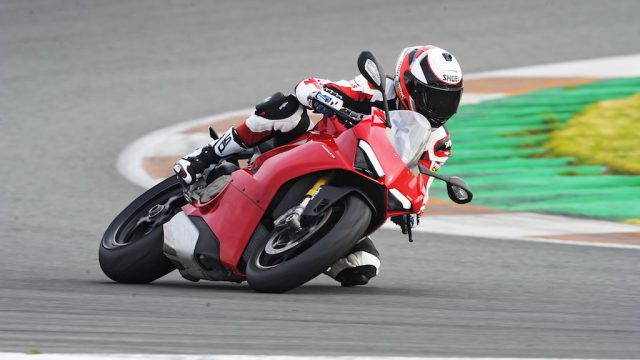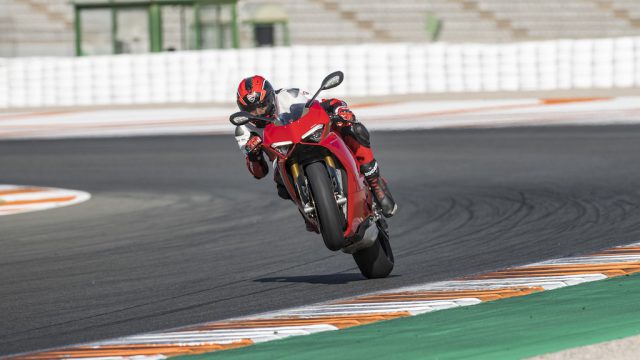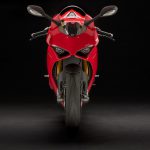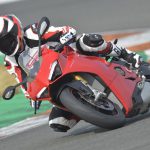Dancing to a new beat
In the late 1970s Ducati was in such a financial pickle, that it seriously considered scrapping motorcycle production in favour of diesel-engine pumps. Four decades later the Bologna-based company has produced arguably of the most impressive and technologically advanced superbike we’ve yet seen

Valencia’s Circuit Ricardo Tormo is a technical track, the current crop of production superbikes will spend a lot of the lap in second gear, snatching third a few times, and fourth gear as you round the arcing left-hander that leads onto the straight. Down the main chute, fifth gear and heading towards 290km/h is what you’re going to get. While Ducati’s new 157.5kW (214hp) V4 engine wrapped in a 195kg (kerb/claimed) package may want for something of Phillip Island proportions, there is more to Ducati’s latest offering than just big power figures. The technical Valencia circuit is a place where a joyous smorgasbord of electronics and an easy-handling chassis can be put to the sword – and the Panigale V4 has all of those things.

In the lead-up to the launch, I wondered whether this new era of Ducati superbike would feel the same as the outgoing V-twin era, albeit with two additional cylinders. I liked the V-twin Panigale, but I found it hard work to ride in an everyday scenario and out on the track I struggled to muster the level of aggression required to get the most out of it.

Ducati’s catchphrase for its new 1103cc Desmosedici Stradale V4-powered Panigale is A New Opera, but when I thumbed the starter on the Öhlins-shod S model, the note from the 4-2-1-2 exhaust was more like a V-twin! The firing order for the new V4 engine, dubbed Twin Pulse (see breakout), provides the bike with a certain level of familiarity even though it’s an all-new design. Despite the larger engine, the bike is still quite narrow across the shoulders with Ducati’s new Front Frame chassis (see breakout) at the heart of the slim lines. The dual-layer fairing design is wide around the nose area where two large air intakes have swallowed the slim full-LED headlights and daytime running lights – making it the most aggressive-looking Panigale yet.

The fairing hugs close to the tank, which isn’t really the fuel tank at all – that’s located closer to the rider and extends underneath the seat – the area just behind the steering head is instead where the bike’s electronic brain is stored. The previous Panigale’s side-mounted shock is gone, replaced by a more conventional unit and the curvaceous rear-end is as Italian as you’re going to get.

A new five-inch TFT dash is super-bright and offers all the usual information at the press of a switch-block button, with a large circular rev-counter taking up most of the screen space. As revs rise, a white trail travels around the circular display changing to orange, then to red as the engine reaches its 14,500rpm rev limiter. The selected riding modes of Street, Sport or Race as well as the programmable parameters for traction control (DTC EVO), wheelie control (DWC EVO), slide control (DSC), power launch (DPL EVO), engine braking (EBC EVO) and ABS Cornering EVO are all displayed full time. The term EVO refers to the latest generation of electronics which have been developed especially for the new V4. At the heart of the electronics is a six-axis IMU, even the Ducati Quick Shift (DQS EVO) in now lean-angle sensitive.

Riding modes Street, Sport and Race (there’s also Track mode which displays a large GPS-enabled lap timer) all receive the full complement of power at 157.5kW (211hp) but in an increasingly less subdued manner as you work your way from Street through Sport and onto Race. The default setting for the swag of electronic ass-savers also decreases in sensitivity for each mode, with a few additional goodies reserved for Race mode.

A welcome addition to the new electronics packages is one button which allows quick and easy mode changes, and another for adjusting the intervention levels for the individual electronic nannies – even while on the move. Adjusting the electronics on the 1299 Panigale was a complicated affair, but Ducati has scored a bullseye with the new more intuitive system. It’s quick, easy to understand, and everything is displayed full time on the TFT screen.

Finally, it’s show time! A thumbs up from the track controller, and it was visor down, rising revs and clutch out. Exiting pitlane I pointed the big red nose of the Ducati at turn two, lit the wick, and things got crazy. I now know what it feels like to use an aircraft-carrier slingshot; the engine delivers its power like a tidal surge. There wasn’t even a hint that a gear change would be required before I reached my braking marker. A light dab on the gear selector dropped the engine a cog with a lovely blip from the electronics – no surprise the quick-shifter is spot on – and I was already through turn two while my brain was 200 metres behind. Accelerating down the straight for the first time unleashed a meaty MotoGP Desmosedici-style growl from the exhaust. Tucked into the fairing I realised the circular rev counter was no match for my long-sighted spectacles, the numbers are too small to read, and I wasn’t going to afford the dash more than a cursory glance at those speeds. So I just kept feeding the engine gears which it happily devoured. The power delivery from the V4 is so thick and linear it makes the whole bike come alive, the head shakes and the rev-limiter appears from nowhere. The overhead sign on the main straight signified it was time to test Brembo’s latest Stylema Monobloc calipers, the newest evolution of the company’s famous M50 kit. The weight-saving claim of 70g per caliper meant little as I entered the braking zone at 280km/h, I just squeezed the lever and hoped the four 30mm pistons gripping each of the 330mm discs up front would do their job. The fact that I had to get back on the power before the apex answered my question. Braking has never been an issue with the Panigale, and nothing has changed. I just wished I’d added more push-ups to my training regime – phew, they bite hard and stay bit.

For the first session, I felt all elbows and knees. Everything felt right, I just needed to get my act together. The bike was delivering on a level that was catching my brain by surprise. Adding to my frustration was the 10mm higher footpeg position. A single centimetre may not sound like much when you consider the seat height is unchanged at 830mm, but my long legs struggled to find enough room to allow my feet to move around on the pegs. The ergonomics on the rest of the bike are superb; the bike felt instantly comfortable, maybe adjustable rearsets are the answer.

Race Mode was selected, and the more direct throttle response was evident from the first corner when the front wheel began lifting. This mode also allows further exploration of the impressive electronics package. Thanks to its new six-axis IMU the Panigale V4 not only makes riding more fun, but it encourages you to try things you may never have had a crack at, including powersliding out of turns and backing the thing into them. Setting the ABS to level 1 or 2 disconnects the ABS on the rear. Level 2 allows a certain amount of sideways drift under braking – all controlled by a sophisticated algorithm best left to the boffins. The idea is to encourage you to have a go. The IMU keeps on eye on brake pressure, lean angle, traction, yaw and the angle of the rear wheel in relation to the front. In ABS Level 2 you can simply smash the rear brake as hard as you like, let the rear slide out and the computer will look after the rest. As your backing-in skills improve, you can begin to modulate the pressure in the rear brake for a better feel and then, when you think you have mastered it, you can switch to ABS Level 1 which completely frees up the rear and leaves it all to you.

Level-1 ABS also teaches you how to hold maximum front brake pressure right to the apex because the system gently releases the front brake pressure as the lean angle increases. There’s also fun to be had on corner exit thanks to two-levels of slide control (DSC EVO). The system calculates the bike’s lean angle, rate of slip and available traction and then lets the rear wheel spin up and slide to the point that looks cool but remains controllable. Level 2 for beginners, Level 1 for the pros. The Panigale launch was the first I have attended where the host actively encouraged everyone to leave blackies and not a single bike was dropped.

The V4 S rides on Öhlins’ semi-active suspension with a NIX 30 fork, TTX 36 shock, and Öhlins steering damper all under the control of the Smart EC 2.0 system. In Dynamic mode, the base settings of the suspension increase in stiffness between the three modes, or you can play with the virtual clickers and have the same freedom as a fully adjustable manual package, with the added bonus of being able to save or reset to default

The system also has a tricky thing called Objective-Based Tuning (OBTi). So instead of playing with compression and damping you simply ask for a little less front stiffness under braking. The system will then work from the new base settings to provide the best suspension reactions for the way the bike is being ridden. It’s all based on calculations being made hundreds of times per second. It’s especially helpful for big guys like me who have a lot of weight shifting around the bike.

Braking into medium and slow corners is where I noticed the biggest difference between the new V4 and the 1299, which I rode on track two weeks earlier. The V4 doesn’t feel like it’s asking as much of the front tyre and the change of direction feels much faster. Despite a slight increase in weight, the whole package feels more nimble, and the feedback from the front and rear of the bike is exceptional. It’s hard to pinpoint just one thing that is making the bike a joy to ride; the new Front Frame chassis, a longer swingarm, new profile tyres and the counter-rotating crankshaft all seem to be doing their bit for the V4’s handling.

For the last session of the day I set DWC Evo (wheelie control), DSC (slide control), DTC Evo (traction control) and ABS all to level 1. It was a great run that revealed how easy the power is to control via the right hand, even though there is so much of it on tap. As I passed the chequered flag to close out the day, I realised there was still much to test on the new bike, one day is barely enough to fully evaluate a machine packed with so much new mechanical and electronic magic, but it left me hugely impressed.

The Panigale V4 already has tongues wagging and chops drooling across the sportsbike buying spectrum, and for a good reason – the performance is as impressive as the spec sheet suggests. The engine is a beast, but the brilliant electronics make it child’s play to use, which allows mere mortals like me an opportunity push the bike much closer to the edge than we would have previously dared. It’s a shame the sidestand is still a bugger. There’s plenty of questions still to be answered about the new Panigale; including how it will handle everyday road-riding duties. Looks like I’ll be forced to ride again soon. It’s a tough gig!

















